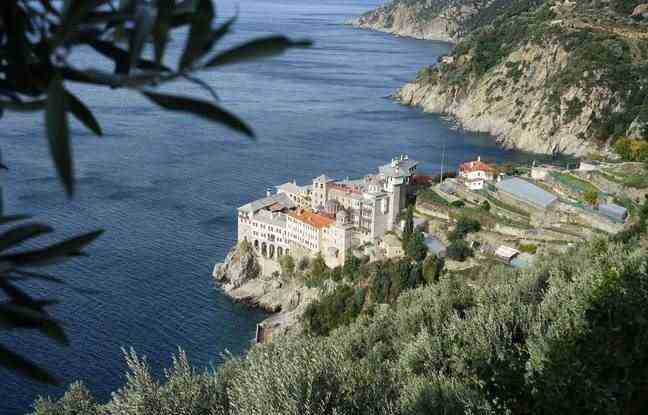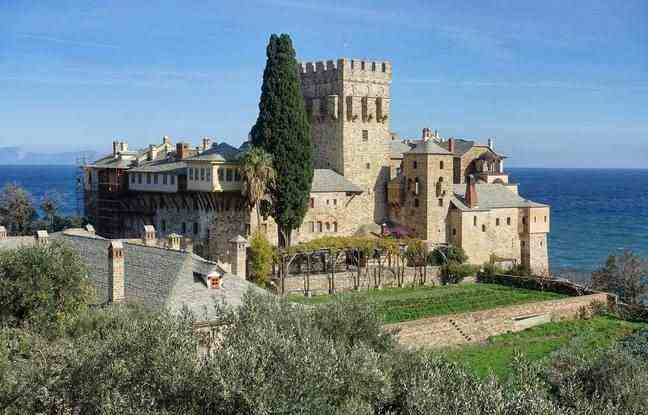Athos is the survival of a millennial past. Staying there shakes things up. This mountain, which culminates at 2,030 meters above the Aegean Sea, gave its name to a sacred peninsula, separated from profane Greece. Defended by a steep shore, it stretches over 50 kilometers of pine forests and limestone rocks, where the Orthodox monks anchor their lives, away from everything except God.
This closed country is exclusively populated by men, whose ageless figures seem to emerge from Byzantine frescoes. In the 11th century, an imperial bull prohibited access “to any woman, any eunuch and any smooth face”. A rule strictly respected ever since. As soon as he arrived on the Holy Mountain », each candidate for monastic life thus lets his beard grow and adopts the black cassock, symbol of his death to the outside world.
In the twenty monasteries of the peninsula, the religious devote themselves to prayer with the same devotion as their Christian ancestors of the Byzantine Empire. To this community life punctuated by offices, others prefer the eremitic austerity of huts scattered in the maquis or cells clinging to the cliffs. All this represents innumerable buildings connected to each other by a network of paths, which wind along the seaside or run through the forest.
The pilgrims endowed with the pass called diamonitirion are allowed to walk in this preserved space, conducive to contemplation. On the slopes of Mount Athos, no plastic waste or parasitic noise. Nothing but the surf of the waves and a Mediterranean nature full of sun.

The Holy Community has a vocation of hospitality. Each monastery therefore has a wing reserved for lay visitors. Crossing the threshold of the Grigoriou monastery, walkers coming from Simonopetra are traditionally welcomed with a Turkish delight and a glass of tsipouro, an eau-de-vie supposed to perk them up.
After assigning them a place in the dormitory, the hotelier Father Siméon tells them the time of the mass: “You don’t have to attend, rest. At the end of the office, come join us for the meal. Tonight is a party. There is fish! Celestial and terrestrial foods being inseparable, the door of the refectory faces that of the church. We eat there in silence, quickly, and with great sips of wine.

Well-hidden treasures
After the foundation of the Great Lavra by Saint Athanasius the Athonite in 962, there were up to 300 communities gathering 7,000 monks on Mount Athos. The Russian revolution, the two world wars, and the Greek civil war, thwarted vocations in the Orthodox countries, emptying very many monasteries of their residents. But since the 1970s, a spontaneous influx of novices has reversed the trend.
Today there are just over 1,800 monks on the Holy Mountain, including about ten French. Among the latter, Brother Macaire appreciates being able to chat with the rare French-speaking visitors to Simonopetra. “Every monk is different. Some of us have taken a vow of silence. This is why brothers are leaving the monasteries of Meteora to join us. There, tourism is a problem. »

The Monastic Republic of Mount Athos has been part of Greece since 1924, but remains autonomous in its management and manages to enforce its isolation. Its council, which sits in the village of Karyès in the center of the peninsula, is the oldest incumbent government in the world. By the 1980s, the Holy Mountain monasteries were falling into disrepair. But the entry of Greece into the European Community, and the classification of the peninsula as a UNESCO World Heritage Site, have made it possible to finance their restoration.
With their massive walls, pierced by narrow windows, many monasteries evoke fortified villages, ready for any attack. An impression confirmed inside, where a tangle of courtyards, galleries, stairs and balconies surround a central church, the katholikon blood colored. From the windows of their dormitory, pilgrims can observe the brothers busy on the terraces of olive trees and in the vegetable gardens. Because on Mount Athos, you eat by the sweat of your brow.

The monasteries are in the image of these monks. Simple and stark on the outside, rich and complex on the inside. Each is a veritable conservatory of wall paintings, goldsmith and embroidery masterpieces, illuminated manuscripts, icons worn by kisses. In the churches, the gilded iconostases conceal the sanctuaries under panels sculpted with extreme virtuosity.
From the vestibule of katholikon, passing lay people can attend services which sometimes last until dawn. Orthodox songs with deep voices make them lose all sense of time and space. Like ghosts, the black cassocks come and go by candlelight. And in the semi-darkness of the ceremony, the journey to Byzantium begins.

Go
Visitors who come to the door of a monastery are lodged and fed free of charge. But Mount Athos is not a tourist site. Its access is therefore regulated. Of the approximately 120 male pilgrims allowed daily, only ten non-Orthodox are admitted.
To try your luck, you have to reach Thessaloniki airport, where Hertz offers a whole range of vehicles for hire, from the economical city car to the comfortable SUV. A two-hour drive then awaits travelers to Ouranoupoli, the last secular locality before the Holy Mountain. Allow €10 for two days of parking in the municipal car park. The pilgrims’ office is right next door. Against 25 € and the negative result of an antigen test, execrable agents deliver the diamonitirion, valid for four days. Once you have this pass in your pocket, head for the port, 200 meters away, to board a ferry to Mount Athos. Two possible options: fast ferry for the port of Dafni or the slow ferry which serves all the monasteries with access to the sea.
Housing
Gateway to Mount Athos, Ouranoupoli is a charming little seaside resort with multiple accommodation options. If the hotels are taken over by groups of Russian or Serbian pilgrims, the guest houses offer a more picturesque setting. At the entrance to the village, the Pension Irini is a haven of tranquility. More central, Archontariki allows you to reach the pilgrims’ office on foot.
Reservations on 0030 697 288 1940
Information
After a pilgrimage to Athos, the Hellenic Tourist Office website proposes to continue discoveries throughout the region of Chalkidiki.

